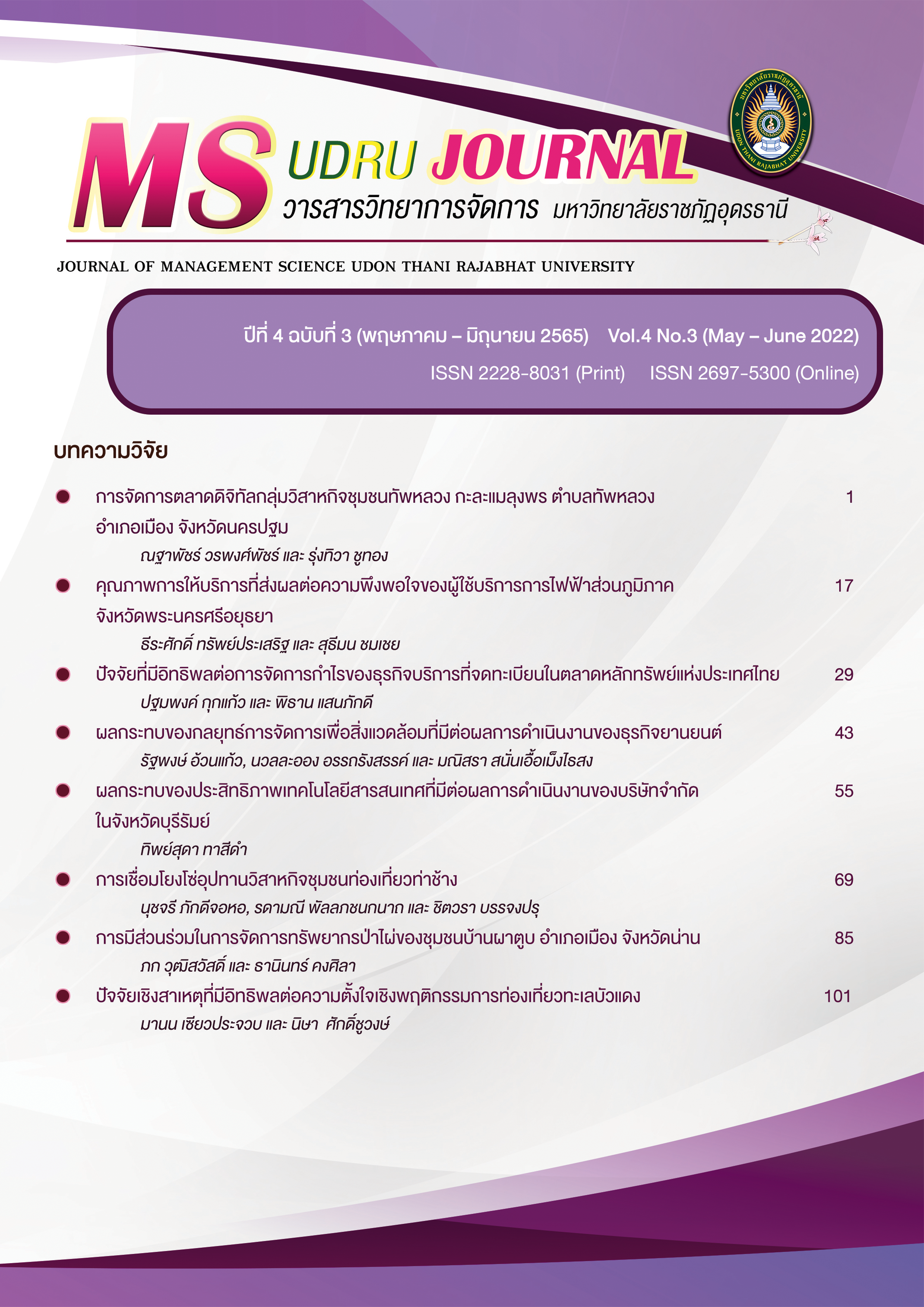ปัจจัยเชิงสาเหตุที่มีอิทธิพลต่อความตั้งใจเชิงพฤติกรรมการท่องเที่ยวทะเลบัวแดง
Main Article Content
บทคัดย่อ
การวิจัยในครั้งนี้มีวัตถุประสงค์เพื่อ 1) พัฒนาแบบจำลองความสัมพันธ์เชิงสาเหตุที่มีอิทธิพลต่อความตั้งใจเชิงพฤติกรรมการท่องเที่ยวทะเลบัวแดง 2) ศึกษาปัจจัยเชิงสาเหตุที่มีอิทธิพลต่อความตั้งใจเชิงพฤติกรรมการท่องเที่ยวทะเลบัวแดง กลุ่มตัวอย่างคือนักท่องเที่ยวที่มาเยือนทะเลบัวแดงจำนวน 260 คน สุ่มตัวอย่างแบบหลายขั้นตอน เก็บข้อมูลด้วยแบบสอบถาม ทำการวิเคราะห์ข้อมูลด้วยวิธีวิเคราะห์แบบจำลองความสัมพันธ์เชิงโครงสร้างตามความแปรปรวนร่วม ผลการวิจัยพบว่า แบบจำลองความสัมพันธ์เชิงสาเหตุประกอบไปด้วย ภาพลักษณ์แหล่งท่องเที่ยวมีอิทธิพลทางตรงเชิงบวกต่อความพึงพอใจและความตั้งใจเชิงพฤติกรรมการท่องเที่ยว ความพึงพอใจของนักท่องเที่ยวเป็นตัวแปรส่งผ่านของอิทธิพลทางอ้อมระหว่างภาพลักษณ์แหล่งท่องเที่ยวที่มีต่อความตั้งใจเชิงพฤติกรรมการท่องเที่ยว
Article Details

This work is licensed under a Creative Commons Attribution-NonCommercial-NoDerivatives 4.0 International License.
บทความที่ได้รับการตีพิมพ์เป็นลิขสิทธิ์ของคณะวิทยาการจัดการ มหาวิทยาลัยราชภัฏอุดรธานี
ข้อความที่ปรากฏในบทความแต่ละเรื่องในวารสารวิชาการเล่มนี้
ไม่ใช่ความคิดเห็นและความรับผิดชอบของผู้จัดทำ บรรณาธิการ กองบรรณาธิการ และคณะวิทยาการจัดการ มหาวิทยาลัยราชภัฏอุดรธานี ความรับผิดชอบด้านเนื้อหาและการตรวจร่างบทความแต่ละเรื่องเป็นความคิดเห็นของผู้เขียนบทความแต่ละท่าน
References
กองเศรษฐกิจการท่องเที่ยวและกีฬา. (2563). สถิตินักท่องเที่ยวภายในประเทศ ปี 2563 (จำแนกตามภูมิภาคและจังหวัด). กระทรวงการท่องเที่ยวและกีฬา. สืบค้นเมื่อ 12 ตุลาคม 2563, จาก https://www.mots.go.th/more_news.php?cid=504andfilename=index.
นิมิต ซุ้นสั้น และ ศศิวิมล สุขบท. (2563). ความสัมพันธ์เชิงสาเหตุระหว่างภาพลักษณ์แหล่งท่องเที่ยว ความผูกพันกับสถานที่ ความพึงพอใจโดยรวม และความตั้งใจเชิงพฤติกรรมของนักท่องเที่ยวชาวตะวันตกในจังหวัดภูเก็ต. จุฬาลงกรณ์ธุรกิจปริทัศน์, 42(1), 68-83.
พบพร โอทกานนท์ และ เยาวภา ปฐมศิริกุล. (2556). รูปแบบคุณภาพการบริการ ภาพลักษณ์แหล่งท่องเที่ยว และความพึงพอใจที่ส่งผลต่อความตั้งใจเชิงพฤติกรรมการท่องเที่ยวแบบพำนักระยะยาวของชาวยุโรปและอเมริกัน. วารสารธรรมศาสตร์, 32(1), 35-55.
Alegre, J., Cladera, M. (2009). Analysing the effect of satisfaction and previous visits on tourist intentions to return. European Journal of Marketing, 43(5/6), 670-685.
Artuger, S. & Cetinsoz, B. C. (2017). The Impact of Destination Image and the Intention to Revisit. A Study Regarding Arab Tourists., European Scientific Journal, 13(5), 82-98.
Baniya and Paudel. (2016). An Analysis of Push and Pull Travel Motivations of Domestic Tourists in Nepal. Journal of Management and Development Studies, 27, 16-30.
Bollen, K.A. (1989). Structural Equations with Latent Variables. New York: John Wiley and Sons.
Boulding, W., Kalra, A., Staelin, R., & Zeithaml, V. (1993). “A dynamic process model of service quality: from expectations to behavioral intentions”. Journal of Marketing Research, 30(1). 7-27.
Chen, C.-F., & Chen, F.-S. (2010). Experience quality, perceived value, satisfaction and behavioral intentions for heritage tourists. Tourism Management, 31(1), 29-35.
Chen, CF., & Tsai, D. (2007). “How destination image and evaluative factors affect behavioral intentions?”. Tourism Management, 28, 1115-1122.
Chiu, W., Zeng, S., & Cheng, P. S. T. (2016). The influence of destination image and tourist satisfaction on tourist loyalty: A case study of Chinese tourists in Korea. International Journal of Culture, Tourism, and Hospitality Research, 10(2), 223-234.
Dickman, S. (1996). Tourism: An Introductory Text. 2nd ed. Australia: Hodder Education.
Fishbein, M., & Ajzen, I. (2011). Predicting and changing behavior: The reasoned action approach. NewYork: Psychology Press.
Fornell, C., & Larcker, D. F. (1981). Structural Equation Models with Unobserv-able Variables and Measurement Error: Algebra and Statistics. Journal of Marketing Research, 18, 382-388.
Gronroos, C. (1984). Service quality model and its marketing implications. European Journal of Marketing, 18(4), 36-44.
Hair, J. F., Black, W., Babin, B. J. & Anderson, R. E. (2010). Multivariate Data Analysis: A Global Perspective. 7th ed. Pearson Education: Upper Saddle.
Kani, Y., Aziz, Y. A., Sambasivan, M., & Bojei, J. (2017). Antecedents and outcomes of destination image of Malaysia. Journal of Hospitality and Tourism Management, 32, 89-98.
Kotler, P., & Armstrong, G. (2010). Principle of Marketing. 13th ed. New Jersey: Prentice-Hall.
Kotler, P., & Keller, K. L. (2009). A Framework for Marketing Management. 4th ed. New Jersey: Prentice-Hall.
Molinillo, S., Liebana-Cabanillas, F., Anaya-Sanchez, R., & Buhalis, D. (2018). DMO online platforms: Image and intention to visit. Tourism Management, 65, 116-130.
Prayag, G. (2009). Tourists' evaluations of destination image, satisfaction, and future behavioral intentions--The case of Mauritius. Journal of Travel and Tourism Marketing, 2, 836-853.
Raykov, T., Gabler, S., & Dimitrov, D. M. (2015). Maximal reliability and composite reliability: Examining their difference for multicomponent measuring instruments using latent variable modeling. Structural Equation Modeling, 23, 384-391.
Tasci, A.D.A, & Boylu, Y. (2010). Cultural comparison of tourists' safety perception in relation to trip satisfaction. International Journal of Tourism Research, 12, 179-192.
The Nation Thailand. (2017). CNN names Isaan as one of best places worldwide to visit this year. สืบค้นเมื่อ 12 ตุลาคม 2563, จาก https://www.nationthailand.com/in-focus/30306979.
Zeithaml, V. A., Bitner, M. J., & Gremler, D. D. (2009). Service marketing: integrating customer focus across the firm. McGraw-Hill.

